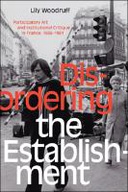Explore

In the decades following World War II, France experienced both a period of affluence and a wave of political, artistic, and philosophical discontent that culminated in the countrywide protests of 1968. In Disordering the Establishment Lily Woodruff examines the development of artistic strategies of political resistance in France in this era. Drawing on interviews with artists, curators, and cultural figures of the time, Woodruff analyzes the formal and rhetorical methods that artists used to counter establishment ideology, appeal to direct political engagement, and grapple with French intellectuals' modeling of society. Artists and collectives such as Daniel Buren, André Cadere, the Groupe de Recherche d’Art Visuel, and the Collectif d’Art Sociologique shared an opposition to institutional hegemony by adapting their works to unconventional spaces and audiences, asserting artistic autonomy from art institutions, and embracing interdisciplinarity. In showing how these artists used art to question what art should be and where it should be seen, Woodruff demonstrates how artists challenged and redefined the art establishment and their historical moment.
This book is included in DOAB.
Why read this book? Have your say.
You must be logged in to comment.
Rights Information
Are you the author or publisher of this work? If so, you can claim it as yours by registering as an Unglue.it rights holder.Downloads
This work has been downloaded 175 times via unglue.it ebook links.
- 119 - pdf (CC BY-NC-SA) at OAPEN Library.
Keywords
- contemporary art
- European History
- France
- History
- History of art & design styles: from c 1900 -
- History Of Art / Art & Design Styles
- Humanities
- Institutional Critique
- May 1968
- participatory art
- Regional & national history
- Social Practice
- Technocracy
- The arts
- thema EDItEUR::3 Time period qualifiers::3M c 1500 onwards to present day::3MP 20th century, c 1900 to c 1999
- thema EDItEUR::A The Arts::AG The Arts: treatments and subjects::AGA History of art
- thema EDItEUR::N History and Archaeology::NH History::NHD European history
Links
DOI: 10.1215/9781478090298Editions

